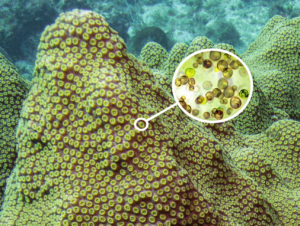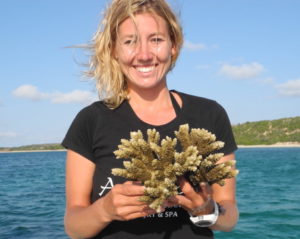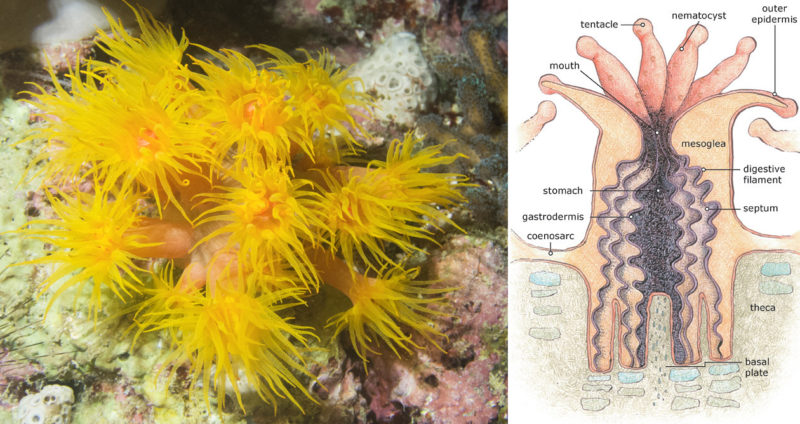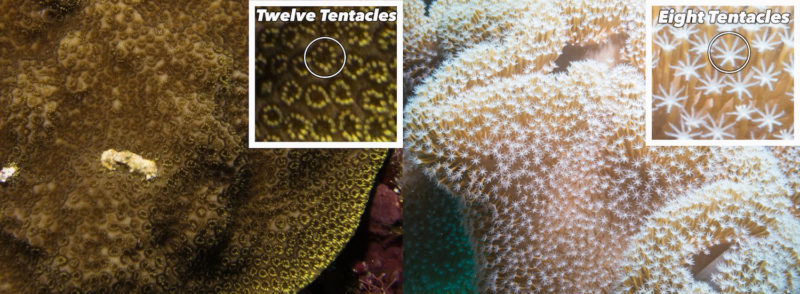It is easy to think of corals as background on a dive. Divers tend to focus on charismatic megafauna like whales and dolphins, or become entranced while searching for sharks and rays. But corals are animals too and deserve our attention. In this two-part series on coral biology, we’ll help you learn to identify coral species while you dive and appreciate their role in a healthy ecosystem.
What is a coral?
Before you start working on coral identification, you should know what it is. Corals are colonial animals made of small polyps. These polyps divide and bud into hundreds of identical polyps, which form a coral colony.
Polyps look like sea anemones and have the same internal body structure. They have a crown of tentacles, a mouth, and a stomach. Any waste the polyp produces will exit through its mouth.
Depending on the coral species, polyps can either be closed and retracted into the colony, or exposed, extending above the surface of the coral. At night, most coral polyps will expose their tentacles while waiting for a passing meal. If you’ve ever done a night dive, you would have noticed the corals look more alive, with large active tentacles.
Coral polyps live in a symbiotic relationship with the photosynthetic algae zooxanthellae. Polyps can derive energy from photosynthesis as well as ingesting plankton or other meaty foods. While we may not think of corals as predators, some species have long sweeper tentacles that emerge at night, catching anything in their path and sting other corals that encroach on their territory.
Hard coral vs. soft coral
There are two general categories of coral, hard coral and soft coral. Both are within the scientific class Anthozoa, but are divided into two subclasses, Hexacorallia and Octocorallia. This guide focuses on hard coral (Hexacorallia), but it’s still important to touch on the differences and similarities between the two types.
The biggest difference, as the name implies, is that hard-coral polyps form hard, calcium carbonate skeletons. Jelly-like mesoglea and rigid, spiny structures called sclerites hold together soft coral polyps, on the other hand.
Second, Hexacorallia polyps are built on a six-fold symmetry, while soft coral (Octocorallia) polyps are built on an eight-fold symmetry. Take a closer look at soft-coral polyps next time you dive and you’ll see there are eight tentacles, whereas hard-coral polyps will form in multiples of six.
Hard coral describes any coral with hard skeleton. This includes small polyp branching, plating and encrusting species, large polyp species like Scolymia, bubble corals, and hammer corals. Soft coral includes vibrantly colored carnation corals, leather corals, sea fans, and gorgonians among others.
Hard coral biology
Because they need light to survive, hard corals live in tropical, sunny waters. They live largely in the euphotic zone, where light penetrates the ocean water to a depth of approximately 230 feet (70 m). Optimal water temperatures for corals are between 73 and 84 F (23 and 29 C), although some can tolerate temperatures up to 104 F (40 C) for short periods. Living inside the corals’ tissue is the photosynthetic marine algae zooxanthellae. The coral provides a home and protection for the algae and, in exchange, these algae absorb sunlight and produce energy for the polyp.
As we mentioned, polyps can get energy from ingesting plankton and food particles. But since they are fixed in place, their energy from food consumption is limited. Coral polyps rely on the sunlight to survive, and without the energy created by the zooxanthellae, they would die.
 Coral bleaching happens when too much light or elevated water temperatures stress the polyps. In response, the stressed polyp expels the zooxanthellae, which gives the coral its color. If the water temperatures don’t fall quickly enough, the polyp will die without this important symbiont.
Coral bleaching happens when too much light or elevated water temperatures stress the polyps. In response, the stressed polyp expels the zooxanthellae, which gives the coral its color. If the water temperatures don’t fall quickly enough, the polyp will die without this important symbiont.
Coral regions
Corals, for the most part, are regional animals. Where you are will determine which coral species you will find. When you are trying to identify any coral, note the region you are in to narrow down possible species.
There are various online resources you can use to identify corals, including the AIMS
coral sheets or corals of the world. These resources separate corals by region.
We’ve separated our coral identification series in two parts to avoid information overload. In the second part, we will explain the difference between large-polyp and small-polyp species, dive deeper into coral reproduction, and introduce scientific terms that you will come across when identifying corals. We will discuss different coral growth forms and prepare you to identify corals in the wild.
By guest author Nicole Helgason
 Nicole Helgason is a PADI Dive Instructor with nine years of professional dive experience. She has taught scuba diving in Canada, Dominican Republic and Indonesia, and has managed dive centers in Mozambique and Baja, Mexico. Nicole has a bachelor’s degree in coastal geography from the University of Victoria and is passionate about coral restoration and coral reefs. She has a website, Facebook, Instagram and Twitter accounts.
Nicole Helgason is a PADI Dive Instructor with nine years of professional dive experience. She has taught scuba diving in Canada, Dominican Republic and Indonesia, and has managed dive centers in Mozambique and Baja, Mexico. Nicole has a bachelor’s degree in coastal geography from the University of Victoria and is passionate about coral restoration and coral reefs. She has a website, Facebook, Instagram and Twitter accounts.




